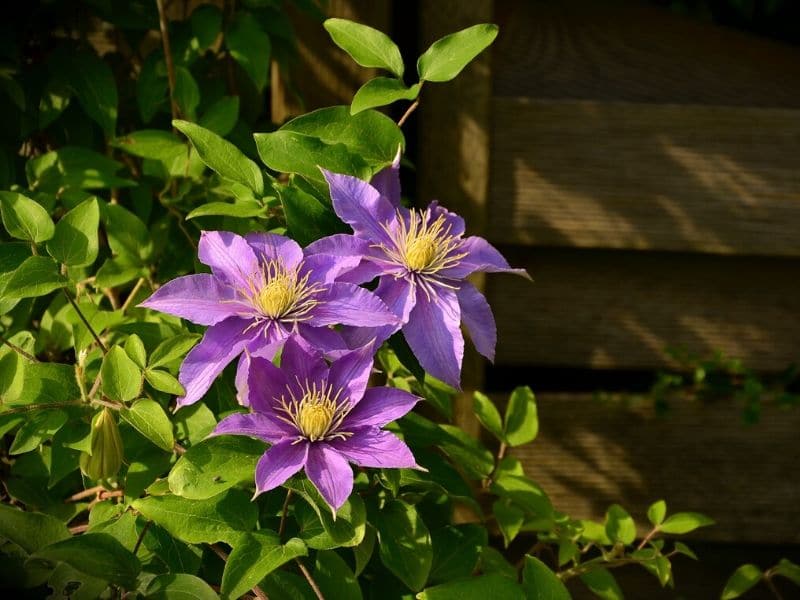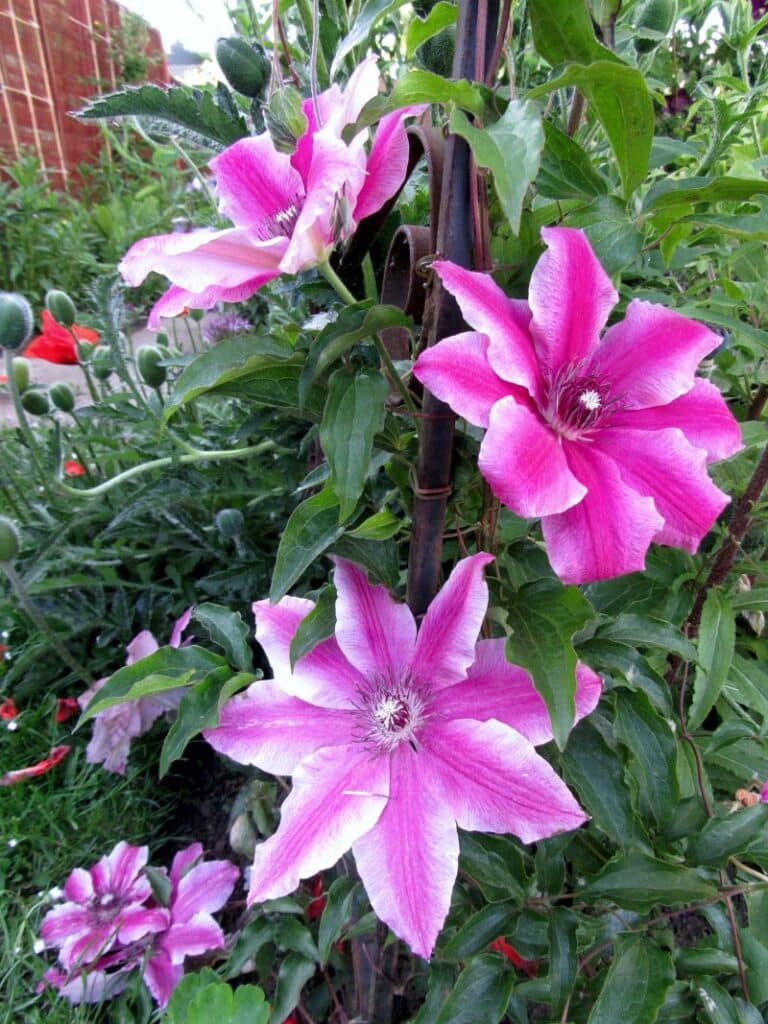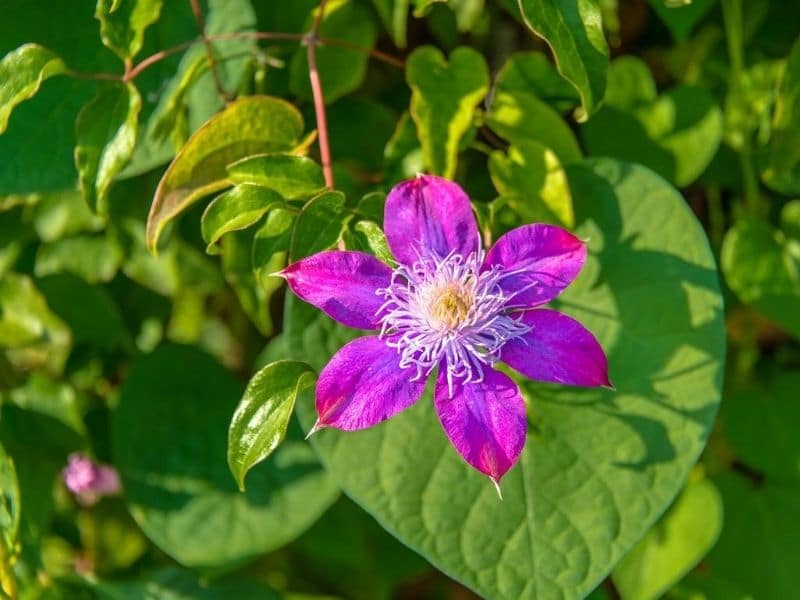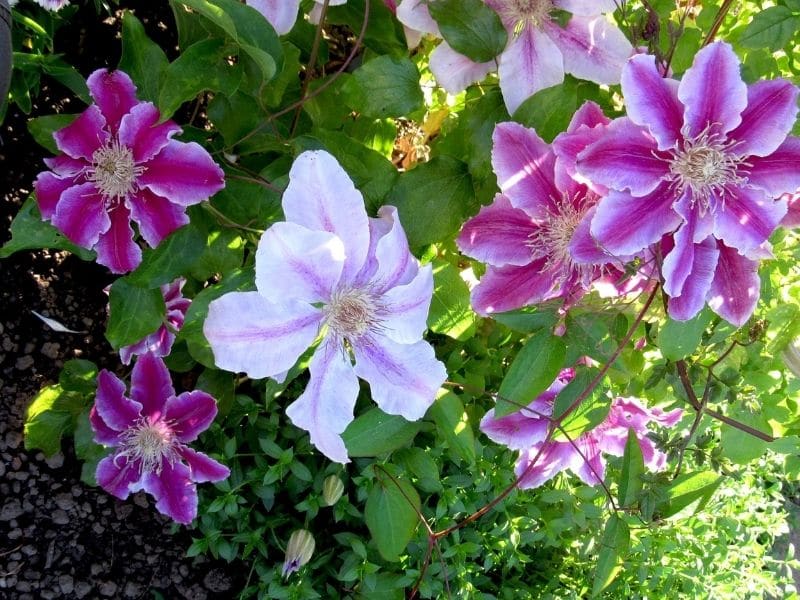The Clematis Vines or the Queen of the Vines is commonly known for its beautiful and showy flowers. Despite having such grandeur, the most common misconception about them is that they are high maintenance and hard to grow. The truth of the matter is that this Queen does not need fancy things and lives simply.
Botanical Information
Belonging in the Ranunculaceae family, the Clematis sp goes by many names such as Clematis Vines, The Queen of the Vines, Leatherflower, Traveller’s Joy, Vase Vine, Virgin’s Bower, Leather Flower, and Old Man’s Beard. There are over 250 species and thousands of varieties of this plant as it is widely used in the landscape due to its aesthetic appeal and growth habits.
Spatial Distribution
It was first seen in Japan, China, India, Australia, New Zealand, Europe, and North America. Generally, the Clematis plants grow in temperate regions and bloom better in places with the same climatic conditions. Given its origins, the Clematis Vine thrives in USDA Zones 3 to 9.

Leaves
The Clematis Vines are deciduous and evergreen broadleaf consists of leaves that are somewhat common to other people’s eyes. They are green and glossy, sometimes characterized as leathery as well.
Depending on the species, their leaf shapes may vary from cordate, lanceolate, elliptical, or deltoid, as well as their leaf margins. It can be either toothed or not. Their leaves are arranged in alternating positions and trichomes are not present.
Clematis Flowers
As beautiful as the Clematis flowers may look, the colorful parts are not petals but sepals. Since this genus has hundreds of species and thousands of varieties, flower shapes and colors vary from bell-shaped, tulip-shaped, tubular, open bell-shaped, star-like, double, semi-double, or single, composed of 4 to 20 petal-like sepals. Usually, it extends to 3 inches in diameter but some can go as wide as 8 inches.

Fruit
At the fruit set, flowers slowly dry and produce achenes or small dry fruits with a silky hair-like tail. Usually, the seeds are brown to a golden brown.
Growth and Development
Despite being called the Queen of the Vines and having the appearance of expensive and high-maintenance plants, the Clematis plant is an aggressive grower and requires less maintenance than other high-value plants. Due to its climbing nature, the plant easily clings and grows with the help of other structures such as trellises.
Also, they have the ability to adapt to their environment quickly because of their tendrils. These are specialized structures that serve as an anchorage for the plant as it grows toward places with more sunlight. It can grow as high as 30 to 50 feet, given the right support.
Different species of the Clematis Vines are classified based on their blooming patterns and, in turn, maintenance schedules are planned after. Aside from the pruning schedules, other caring methods for most species are similar.
When selecting clematis companion plants, consider plants with contrasting colors or complementary foliage, as well as having similar growing conditions.

Clematis Care and Growing Tips
Sunlight Requirement
These vines are sun-loving and should be exposed for at least 6 hours uninterrupted for them to bloom. Although there are varieties that tolerate being planted on shaded areas, such as Alba Luxurians, Purpurea Plena Elegans, and Betty Corning. The mentioned varieties may have smaller flowers than others but it is good for people who are new to gardening and have no full-sun areas to plant.
Water Requirement
In the first year of growth, it is necessary to ensure that the soil is moist throughout the growing season. This can be achieved by watering every week, once or twice a week. Remember to observe the plant and the soil for signs of dryness or overwatering, too much or too little moisture may cause detrimental effects for the Clematis Vines.

Soil Requirement
Clematis vines are perennials and they love to grow in one spot for long periods. Hence, it is important to choose the best planting spot for them. Ideally, the soil should be loamy and rich in organic matter. The root zone should be kept in an area that has a lower temperature. Some soils tend to lose more moisture than others, especially on hot days. Therefore, adding mulch, such as leaves, compost, or coco peat, inches from the stem will help retain moisture.
Temperature
The leaves and the roots differ in temperature requirements. The leaves want to be exposed to the full sun most of the time, resulting in higher temperatures, while the roots prefer to be in a cooler place.
Fertilizer Application
The beauty Clematis brings comes with a cost, in this case, it is the soil nutrients. These vines are known to be heavy feeders. In line with this, the application of complete fertilizers may be done monthly during the growing season. Altering the fertilizer to be supplied to a more phosphorus-rich fertilizer should be done during the flowering season. Failure to do this change may affect the flowering which may result in fewer blooms.

Pruning
Pruning clematis is the most important maintenance activity for these vines and it should be coherent to what type you are planting. Below are the different groups classified based on their time of flowering. Along with each group is how pruning should be done.
Group 1
These are Clematis plants that bloom after it has matured in the previous season. The best way to prune is by removing dead and weak parts. Letting the plants fully bloom during spring before making any extensive pruning is advisable. Usually, heavy pruning may be done during early summer or late spring to give the plant enough time to regenerate for the next season.
Group 2
Under this classification are clematis plants that can produce flowers on both new and old growth. June is when the first peak of flowering occurs and will repeat at the latter part of the season. Heavy pruning is not recommended in this group. Light pruning or removal of dried, dead, and damaged parts should be performed after the first peak of bloom, helping the plant create more blooms in the late parts of the season.
Group 3
Under this group are the species and varieties of Clematis that bloom on new growth and can withstand extensive pruning as it helps in the continuous production of flowers around the latter half of summer or early fall. Pruning for this group is best performed during spring. Aside from the usual removal of dead, dried, and damaged plant parts, pruning 6 to 12 inches of older stems will give way to younger shoots and rejuvenate the plant.

Propagation
Clematis reproduces either through seeds, but young stem cuttings are the common way of propagation. Choosing the right planting material is crucial in this type of propagation. Stems that are not too mature or too young to develop roots.
After choosing the right stem cuttings to plant, preparing the right rooting media using soil that is rich in the organic matter should be done. Plant the stem around 3 inches deep with the crown of the plant on the top part.
Remember that watering deeply is crucial to develop a strong root system for the clematis. The amount of water may be changed to at least an inch deep after a year of growth.
After the cuttings are established, transplanting should be done on a carefully chosen spot in your garden or landscape. Follow the mentioned recommendations for caring mentioned above.
Problems Frequently Encountered
The Clematis Vines usually encounter powdery mildew and wilt. This can be identified if there are fungal spores on surfaces of the plant that are browning or wilting. Fungal diseases are controlled by removing the infected parts and application of fungicides to protect those that are not infected yet. To avoid plant diseases, ensure proper keeping and sanitation of garden tools and selecting disease-free planting materials.

Widely Used Species and Varieties of Clematis
Here are some common clematis varieties:
Clematis heracleifolia
This species is more of a shrub that gives tiny blue hyacinth-like flowers during summer. It grows best during spring and summer and can go as tall and as wide as 4 feet. Then comes winter and this plant dies back to near ground level. It is the plant’s way to survive cold temperatures.
Clematis tangutica
This species belongs to the Group 3 pruning with small bright yellow flowers that are bell-shaped. It blooms and grows vastly and is resistant to heat and drought. Flowering is often seen around July to October.
Clematis viticella ‘Betty Corning’
This variety blooms beautiful lavender bell-shaped flowers throughout the season. Same as C. heracleifolia, spring is the time when this variety is robust and could climb up to 10 feet tall, given the right support such as trellises, poles, or trees. Another similarity is that this variety dies back during winter too.
‘Jackmanii’
One of the classic and all-time favorites due to its versatility and resilience. Despite needing less effort for maintenance, this variety produces magnificent large purple flowers during June and July. This variety of Clematis belongs to the pruning Group 3.
‘Sweet Summer Love’
From its name, this variety produces bluish-violet flowers with white centers around mid-summer and it grows up to 5 feet tall. One of its best characteristics is that it can withstand harsh winter conditions.
‘Comtesse de Bouchard’
This is one of the famous pink flower-bearing Clematis varieties that often blooms from July to August. It grows vigorously and falls under the pruning Group 3.
‘Sweet Autumn Clematis’
This is a strong and sturdy type of clematis but blooms come in late. As a compromise, it produces a mass of fragrant flowers, wherein extensive pruning is a prerequisite as it belongs to pruning Group 3.
‘Cardinal Wyszynski’
This variety blooms majestic and huge crimson flowers that are often observed around July to September. Also, it is under pruning group 2.
‘Vyvyan Pennell’
Under pruning group 2, this variety gives rise to double flowers during the latter parts of the season. At the beginning of the growing season, single flowers may be observed.
Landscape Use of Clematis
The Clematis flower will surely add an element of grandeur to the landscape due to their appearance. Carefully choose the right type of variety depending on the function in the landscape.
Varieties that are robust and produce dense and small flowers are recommended when being used as a screen. It can also be used to cover up some dead trees by letting them cling to the dead trunk. It can also soften some of the man-made fixtures in the landscape, such as arbors, pergolas, fences, and gates.
Flowers may also be picked and used in flower arrangements that may go well indoors, adding that pop of color in your home.
FAQs
See more climbing plants and purple climbing flowers you can grow.
*images by Guard&GalinaBondarenko/depositphotos & Pixabay







